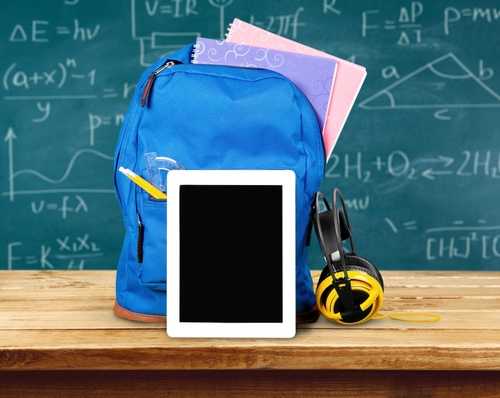San Francisco’s Vision 2025 tackles technology and early literacy
 It seems an almost unknowable question: What will — or should — high school graduates look like in the year 2025?
It seems an almost unknowable question: What will — or should — high school graduates look like in the year 2025?
Beginning with a systematic community-wide visioning process in the 2013-14 school year, San Francisco Unified School District developed its Vision 2025 to take a close look at what will be asked of a 2025 graduate in order to thrive and be successful in San Francisco and beyond.
Superintendent Richard Carranza of San Francisco Unified School District and the board of education considered, for instance, that graduates will need to develop and manage their local, global, and digital identities, and be comfortable separating and switching between the three. Graduates will benefit from being bilingual or multilingual; a 2025 graduate must be technologically fluent as well as college and career ready, with the added challenge that many of those careers have yet to be created.
Community participants looked at trends and data to create a 2025 “Graduate Profile.” They also, in large and small groups, engaged creatively with each other, with research and with information gathered from field trip observations to design possible future learning environments.
Then they started a pilot program to begin to bring that vision to life — starting in first grade.
Next page: A home iPad and reading program takes off
Bringing vision to life
As the first step toward achieving their ambitious vision, SFUSD implemented School and Family Early-Digital Literacy project, which has wrapped up its first year. The project is designed to promote learning to read and write and engagement with the Common Core in language arts and math through meaningful use of iPads.
The project put classroom sets of iPads loaded with reading and writing apps into the hands of all first graders at four of the district’s underserved elementary schools, and provides both training and an iPad to their parents to help extend literacy learning beyond the classroom. Several community partners—such as YMCAs and the Mission Economic Development Agency—help facilitate the training.
To receive the family iPads, parents or guardians took a 20 module, 10 session course with lessons ranging from turning the iPads on and setting them up, to early literacy activities they can do with their child on or off the device, and advanced lessons on specific apps and online resources. The training was offered in English, Spanish, and Cantonese.
The iPads in these classrooms have bigger libraries within them than district officials could have imagined a few years ago. The digital reading platform myON has more than 8,000 books for children. Each student gets their own account, and teachers are granted the ability to track student progress.
A new framework
SFUSD conducted careful research, as the plan was to go slow in order to go fast. The team looked at other programs around the country as well as reviewing other school-to-home technology efforts before developing their own early literacy curriculum in collaboration with an educational nonprofit, Wexford Institute.
The program intentionally started small: the first grade classes in four carefully selected communities became the starting points. One of the important goals of the district is to have students reading at grade level by third grade, but ELA leaders recommended that first graders be targeted because first grade is when students are expected to make the greatest leap in reading ability. Furthermore, the district is beginning to implement the new Common Core assessments, which start in the second grade. By focusing on reading skills for a full year in first grade, students will not be distracted by the test preparation and testing windows that become a necessary part of the second grade curriculum.
Next page: Transforming the classroom for collaboration
The vision builds on work conducted by SFUSD’s deputy superintendent Guadalupe Guerrero, to turn-around the district’s formerly lowest performing schools. He, along with Humanities leaders in curriculum and instruction, worked to roll out the evidence and research-based comprehensive literacy framework workshop model, called Reader’s and Writer’s Workshop, across these schools. The goal was to transform traditional rows and columns of seated students into classrooms with robust leveled classroom libraries, organized into learning centers, with opportunities for dynamic small and full group work, and guided, shared, and independent literacy learning.
“With our strong focus on literacy, effective integration of digital devices helps us further advance the attainment of our graduate profile in young learners,” Guerrero. “It also helps ensure we’re supporting families as their child’s primary teacher.”
Moving forward
Mark Zuckerberg and Priscilla Chan, through their foundation, Startup: Education, became interested in working with San Francisco on both the community and classroom side. Supporting the two-generation approach, bringing families and their kids into the program together, was a natural fit. Many families are low-income and English is not the language spoken at home. The district wanted to honor the knowledge that parents brought to the table and be sensitive to their challenges. Therefore, the program allows parents and students to advance in their own languages, as well as in English.
The pilot program does not significantly rely on any public funds. Instead, donations from Startup: Education, and project participation by a host of community groups, made this scalable pilot possible. Its success will now inform strategic use of public funds.
The key has been engaging the right stakeholders from across the community and nation. The district has learned from the successes and challenges of similar programs, and was also careful to rely on the expert advice of thought leaders within its own administration.
The Early-Digital Literacy pilot is one step toward the vast vision. The district is also poised to introduce a required computer science curriculum, which by 2025 will be in place for all students preK-12. “The emphasis is on teaching programming and algorithmic thinking in developmentally appropriate ways from PreK through graduation,” said Jim Ryan, the district’s STEM executive director.
Rachel Norris is a freelance writer who writes about education and other industries.
- TC- What student choice and agency actually looks like - November 15, 2016
- What student choice and agency actually looks like - November 14, 2016
- App of the Week: Science sensor meets your smartphone - November 14, 2016


Comments are closed.